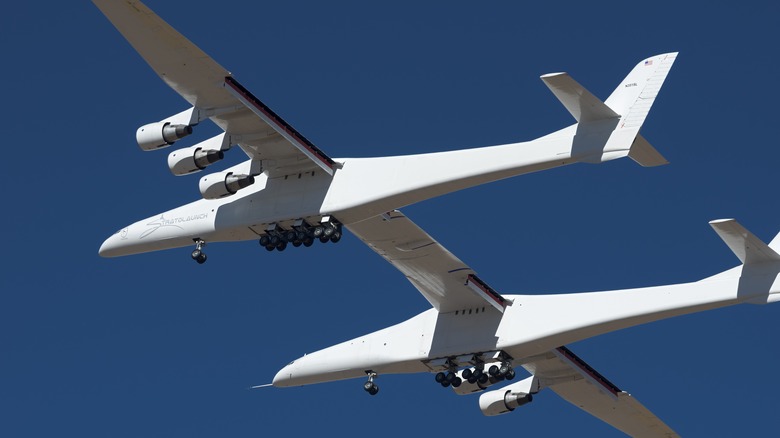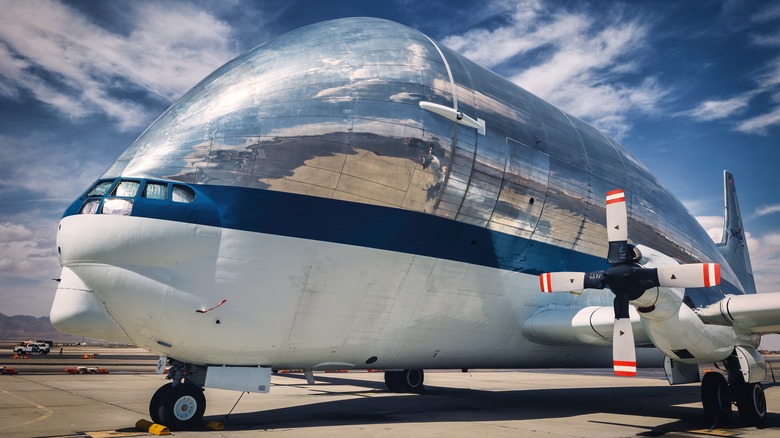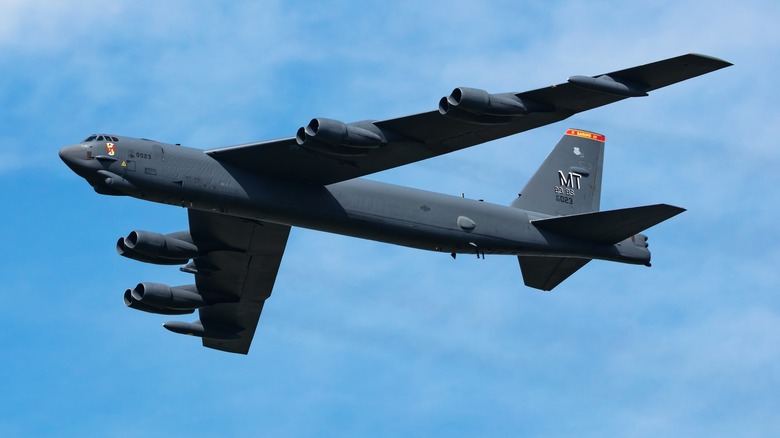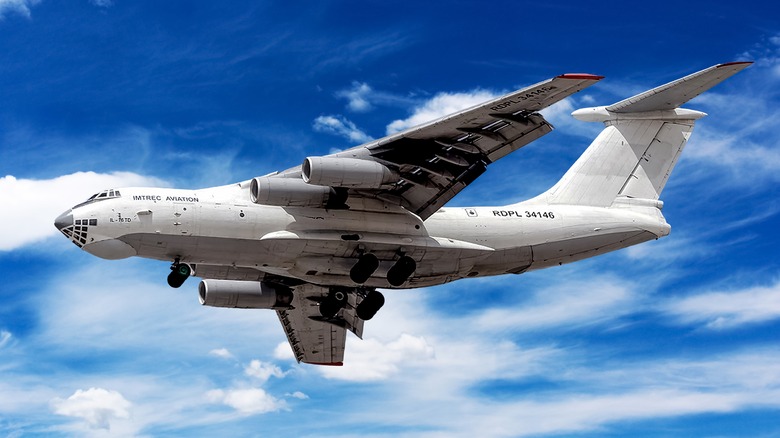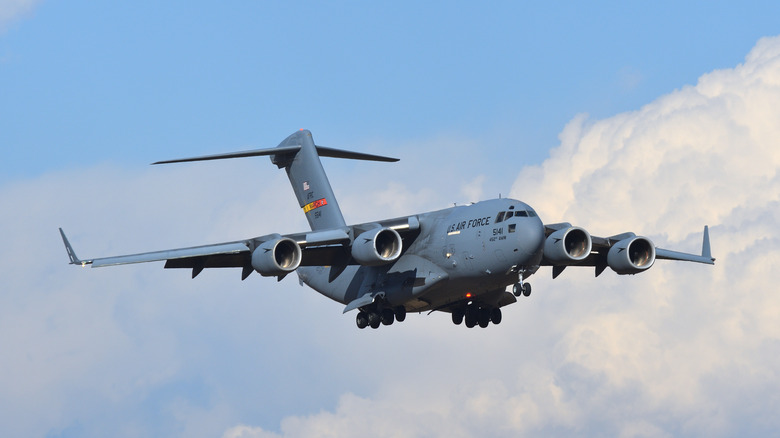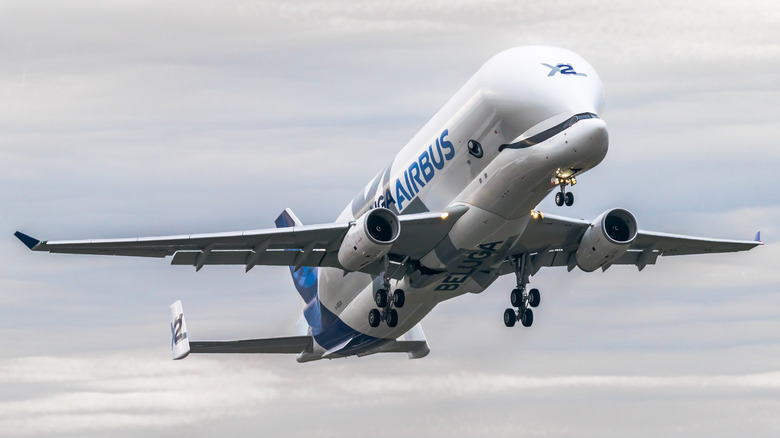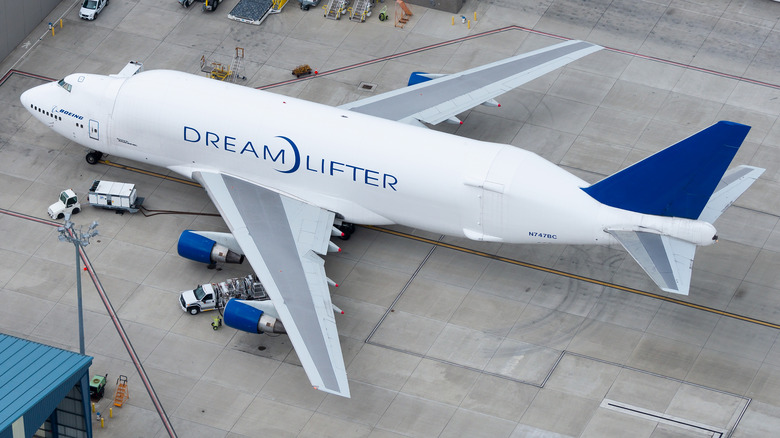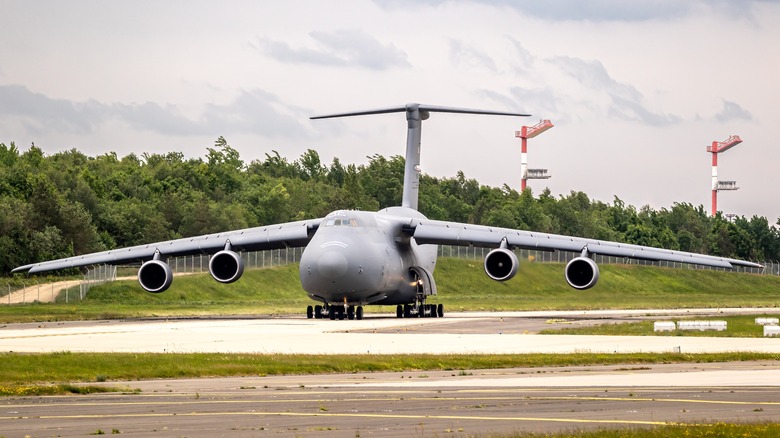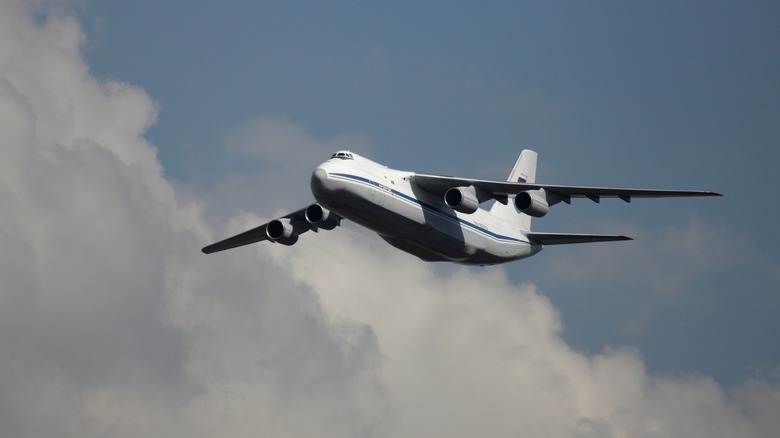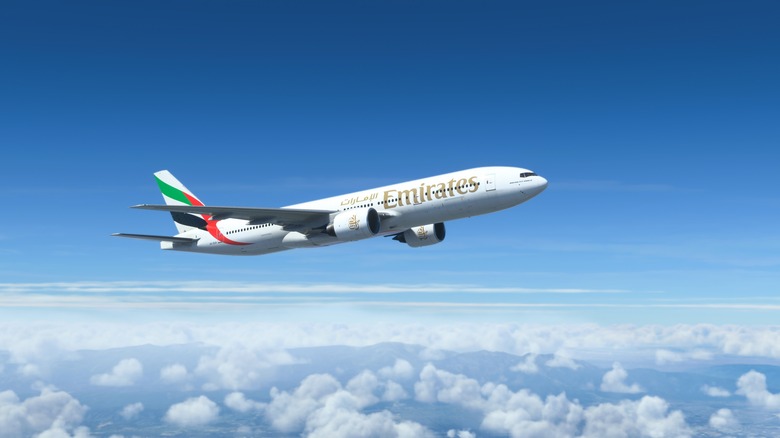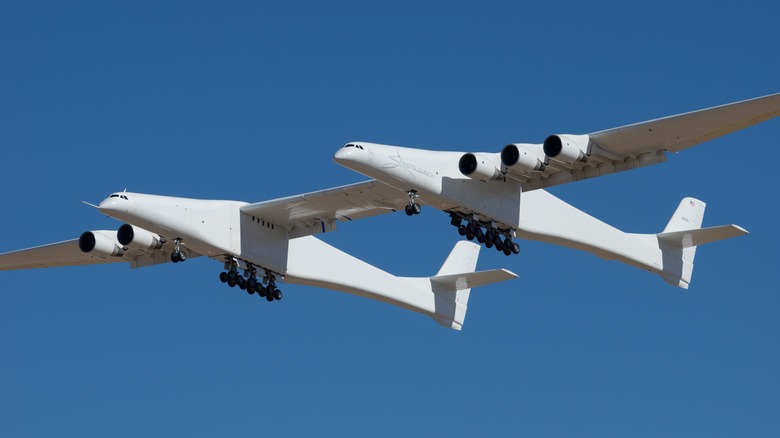The Top 10 Largest Planes In The World As Of 2024
Although aircraft are still a relatively modern invention, they have become the dominant way of moving across large distances. Early planes were rather small and often could only carry a crew of one or two people. But as air travel has become more popular and aircraft have taken on a more important role in military forces, they have had to grow in size. To be as efficient as possible, planes had to get larger.
After all, larger passenger planes can carry more passengers to destinations around the world, while bigger military aircraft can perform more duties, whether transporting cargo, moving massive equipment such as tanks, or deploying troops in far-off locales. Of course, as planes have expanded in size, larger transport aircraft are needed to move the parts used to construct them around.
These are the largest planes in the world, and among them, some of the most expensive military aircraft ever constructed.
10. Aero Spacelines Super Guppy
The Aero Spacelines Super Guppy is not an aircraft you'll be traveling on any time soon, as it's primarily a cargo aircraft. The vehicle is used to transfer goods across vast distances, specifically outsize cargo items like rocket components or parts for the International Space Station. These types of items are simply too big for most aircraft and require specialist carriers to handle their extreme size and weight.
Just five variants of the Super Guppy were ever made, and NASA operates the last remaining working model. The Super Guppy features a truly staggering amount of internal storage capacity. Not only can it carry incredibly large objects on its external fuselage, but its distinctive whale-like shape can open from the front, allowing it to house massive objects internally that no other aircraft can manage.
Requiring a crew of four to operate, the Super Guppy has a total length of 143 feet and a wingspan of over 156 feet. The interior features 2,700 square feet of internal storage space, with a height of 46 feet making for a little over 69,000 cubic feet of capacity. Fully loaded with its maximum cargo weight of 41,000 pounds, the Super Guppy can weigh up to 170,000 pounds.
9. B-52 Stratofortress
Developed and designed by Boeing, the B-52 Stratofortress is a long-range strategic bomber that has been used by the United States Air Force and NASA since 1955. Unlike many of the other aircraft featured here, the B-52 is not a cargo plane but a military vehicle that uses its large size to deliver large payloads to combat arenas worldwide. The bomber came about following the U.S. military's desire to have a replacement for the Convair B-36 Peacemaker that would be able to deploy nuclear weapons.
Over the years, they have continued to be upgraded, and while service with NASA ended in 2007, they are expected to remain in service with the U.S. Air Force well into the 2050s. This means that they will likely have been in active service for 100 years before they are retired. Powered by eight turbojet engines, the aircraft operates at altitudes of up to 50,000 feet and at subsonic speeds of Mach 0.9, remaining in the air for up to 8,8000 miles before needing to refuel.
Modern versions of the B-52 require a crew of five to operate correctly. They are roughly 160 feet long and have a wingspan of 185 feet, with the bomber able to carry a payload of around 70,000 pounds. The armament can include everything from missiles to bombs, in addition to specialist nuclear weapons. When fully loaded, it can weigh well in excess of 300,000 pounds.
8. Ilyushin Il-76
This Soviet Union-era aircraft has been a workhorse of the Russian Air Forces since its introduction in 1975. A strategic airlifter, the plane's main purpose was to transport military personnel and equipment across large distances. However, the reason it has remained relevant despite the advent of larger military transport aircraft is largely down to its versatility. The Ilyushin Il-76 was designed to fly in the harshest of conditions and land without a paved runway.
This has enabled it to tackle a variety of non-military tasks. The Ilyushin Il-76 is widely used as a cargo transport by civilian carriers and has also found itself being utilized as an emergency response aircraft for evacuating large numbers of people and providing humanitarian relief, in addition to being a plane capable of carrying out firefighting duties.
The Ilyushin Il-76 is far from the largest military transport, but it is still sizable. It needs a crew of five people and has a total capacity of 132,000 pounds. In terms of dimensions, the aircraft has a total length of 152 feet, a wingspan of 165 feet, and a height of 48 feet. The plane also has a range of 2,700 miles and is powered by four turbofan engines.
7. Boeing C-17 Globemaster III
Originally manufactured by McDonnell Douglas until Boeing took over, the Boeing C-17 Globemaster III is a military airlifter that fulfills strategic and tactical roles. It is primarily used by the United States Air Force but has also been utilized by other operators during its lifetime, including the Royal Air Force in the U.K., the Indian Air Force, and other American allies such as Australia and Canada.
The C-17 Globemaster III entered service in 1995 and production continued until 2015, with a total of 279 units being manufactured during that time. Taking inspiration from the smaller YC-15 prototype, the C-17 Globemaster III was intended to replace the Lockheed C-141 Starlifter and often works alongside the larger Lockheed C-5 Galaxy to transport troops, equipment, and vehicles to U.S. bases across the globe. Outside of simply transporting cargo, the aircraft is also noted for its ability to act as a medical evacuation transport and airdrop materials.
As an airlift, the C-17 Globemaster III has to be large enough to carry a large cargo, and it has a capacity of 170,000 pounds — enough to transport a single M1 Abrams tank. It has a length of 174 feet, a wingspan of 169 feet, and a total height of 55 feet. The aircraft has a range of 2,780 miles but it can be refueled by the 60-year-old airborne tanker.
6. Airbus BelugaXL
The Airbus BelugaXL arose out of a need for the manufacturer to have a replacement for the original Airbus Beluga, a transport aircraft that was no longer suitable for moving large aircraft components to destinations across the globe. The result of the design process made its first flight in 2018 and a total of six have now been built and are in operation, though Airbus is not planning to produce more.
Based on the Airbus A330-200F, itself a variant of the popular Airbus A330 aircraft, the BelugaXL is taller, wider, and longer than its predecessor, giving it an additional 30% transport capacity. In practical terms, that makes it one of the biggest jets ever made. The more modern cargo plane can carry two A350 jetliner wings, while the original Beluga could only transport one. Able to reach altitudes of 35,000 feet, it operates at a top speed of Mach 0.69 at this height and has a maximum range of 2,600 miles, more than double its predecessor.
Expected to be in flight almost constantly as it transports components, the BelugaXL is built to accumulate up to four million miles a year. It is 207 feet long, has a wingspan of more than 197 feet, and a total height of exactly 62 feet. Within that space, the aircraft is capable of carrying a payload of more than 111,000 pounds.
5. Boeing Dreamlifter
The Boeing Dreamlifter owes its existence to the unique Boeing 787 Dreamliner passenger jet. The aircraft was designed specifically to carry parts and components for the Dreamliner, which are made in various locations around the world. This includes areas in Europe and Asia, with parts ultimately being delivered to the United States for assembly. Compared to Boeing's earlier 747-400 freighter that it was modified from, the Dreamlifter has a cargo capacity that is three times the size, with 65,000 cubic feet of space.
The first flight of the Dreamlifter was in 2005, and it entered service in 2007, with a total of four aircraft being produced since then. They also transported medical supplies during the COVID-19 pandemic, making good use of the expanded cargo hold, which can be loaded as the swing-tail opens up at the back of the aircraft.
The Dreamlifter utilizes four PW 4056 turbofans to provide power, with each engine providing more than 63,000 pound-force of thrust. This allows the aircraft, which has a maximum take-off weight of 803,000 pounds, to reach a cruising speed of Mach 0.82. When fully loaded, it can reach a maximum range of 4,800 miles. In total, it is more than 235 feet long, 70 feet tall, and possesses a wingspan of 211 feet.
4. Lockheed C-5 Galaxy
Although the vast majority of very large aircraft are civilian cargo and transport carriers, there are some examples within the military. A prime example of this is the United States Air Force's Lockheed C-5 Galaxy, a strategic airlifter capable of delivering all kinds of military equipment, vehicles, and weapons to wherever they are needed in the world. 131 C-5 Galaxy planes have been built since the first one entered active service in 1970 and they are expected to remain in service until the 2040s.
When the U.S. military was looking to replace the Douglas C-133 Cargomaster, Lockheed won the contract to develop the C-5 Galaxy, an aircraft capable of moving main battle tanks across vast distances. It is so effective that it is still used to this day to efficiently carry an M1A2 Abrams tank or up to six Blackhawk helicopters across a range of 5,500 miles. When used as a personnel carrier, it can take up to 350 people and all of their gear to a location at speeds of up to 532 mph.
One of the largest planes ever built and a mainstay of the U.S. Air Force, the C-5 Galaxy has been updated and upgraded several times throughout the last few decades. The current model, known as the C-5M, is 247 feet long, 65 feet tall, and has a wingspan of 222 feet.
3. Antonov An-124 Ruslan
The Antonov An-124 Ruslan is a Soviet Union-era aircraft that was developed in Ukraine as a heavy transport military plane. In terms of aircraft that are still in active service, it is the largest military transport plane in the world and an upgraded model began operating as recently as 2014. It was manufactured and designed by Antonov Design Bureau, with the aim of transporting heavy military equipment and vehicles. Production began in the 1970s, and the An-124 Ruslan became operational in 1982.
Like other military transport aircraft, such as the Lockheed C-5 Galaxy, the An-124 Ruslan puts substance over style. In fact, the aircraft actually has a lot of similarities with the latest version of the American-made C-5M Super Galaxy, including its use of composite materials and a double fuselage configuration. Numerous variants of the plane have been used outside of Russia and Ukraine, with Libya, the United Arab Emirates, and even the United Kingdom and Germany using them for civilian and military purposes.
Requiring a crew of eight to operate, the An-124 Ruslan has exceptional range and can reach up to 6,200 miles when its payload is less than 88,000 pounds. Progress D-18T high-bypass turbofans provide the power, allowing the aircraft to travel at 537 mph. Its length is 226 feet, with a height of 69 feet and a wingspan of 240 feet.
2. Airbus A380
The Airbus A380 was the European company's answer to Boeing's dominance in the long-haul market with its 747 model. It is unique in that it has a double-decker configuration across the entire length of the aircraft and 254 have entered service since the launch of the plane in 2007. Emirates possesses the largest number of A380s, with the carrier having some 123 aircraft in its fleet.
In its most commonly used layout, the A380 can carry around 575 passengers across economy, business, and first class. It is certified to carry a maximum of 853 people, but it can only do this if the entire aircraft is outfitted to carry economy-class passengers. Regardless of the configuration, the A380 is the largest passenger airliner in the world.
While it is a similar size to the 747-8, with the Boeing aircraft actually being slightly longer at 250 feet, the Airbus plane is significantly taller and wider. It is some 237 feet long, 23 feet, 5 inches wide, and 79 feet tall. Meanwhile, the wingspan is a massive 261 feet, almost 40 feet longer than the 747-8.
However, the A380 has also been a commercial failure, failing to make back the tens of billions of dollars Airbus invested in the project, despite its efficiency and excellent safety record.
1. Stratolaunch
Officially known as the Scaled Composites Model 351 Stratolaunch, this aircraft is the undisputed king when it comes to sheer size. Funded by Microsoft co-founder Paul Allen, it was originally aimed to provide a way for rockets to fire in the air and launch satellites into orbit through a technique called air-launch-to-orbit. However, following the death of Allen and subsequent sale to Cerberus Capital Management, it is now primarily used to test hypersonic flight systems. Dubbed the Roc, the aircraft has gone through numerous delays since it was announced in 2011 and only conducted its first flight in 2019.
Thanks to the size and complexity of the aircraft, only one Roc has ever been built. The aircraft has a twin-fuselage design, allowing it to affix large payloads between them. The right side houses the cockpit and crew, while the left is used for flight systems and additional cargo space. Up to 12,000 feet of runway is needed for take-off and the aircraft has 12 dedicated landing gears.
The Stratolaunch's two fuselages are each 238 feet long, with a wingspan of 385 feet. While it is not particularly tall, the weight of the structure when empty is over 750,000 pounds and it can carry a payload of up to 550,000 pounds. Powered by Pratt & Whitney PW4056 turbofans, it can reach speeds of 530 mph and has a maximum range of 1,200 miles.
